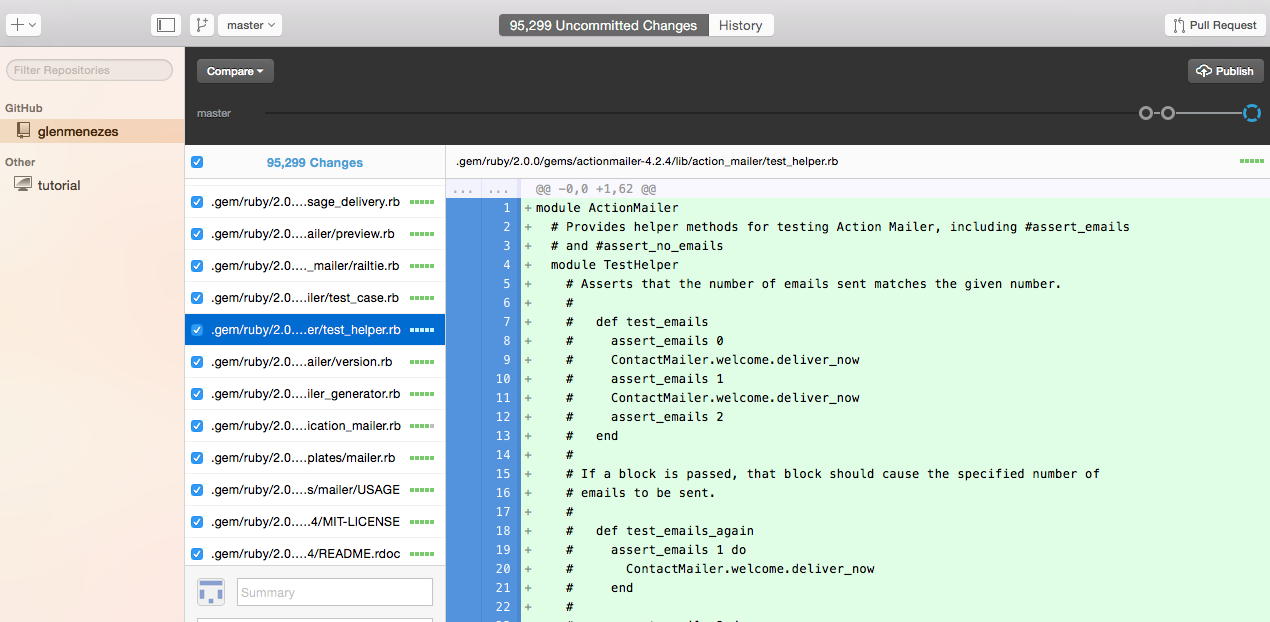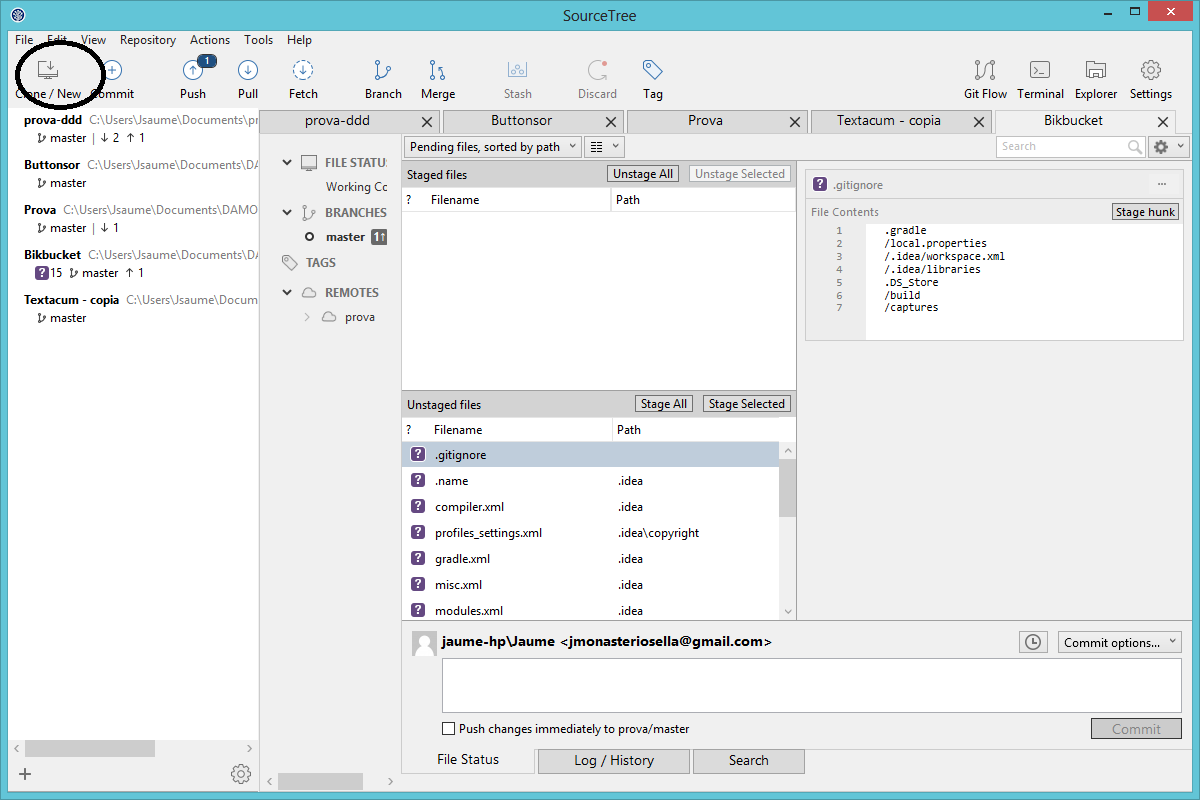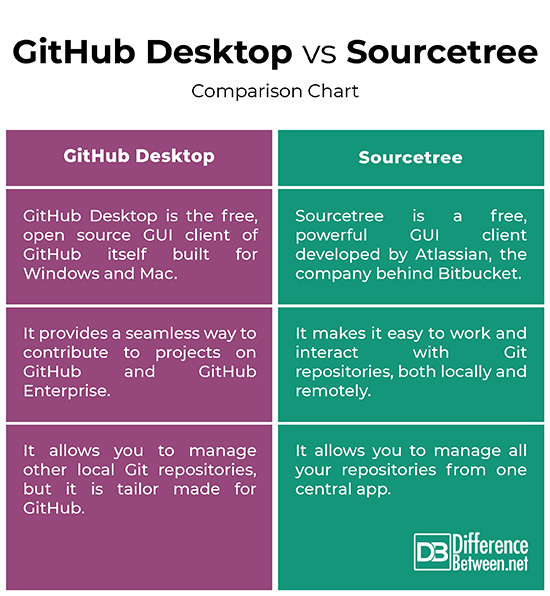Difference Between GitHub Desktop and Sourcetree
There are several tools that can be used to manage Git repositories. GitHub has its own tool called GitHub Desktop that makes it easy for Windows and Mac users to manage GitHub repositories and connections on their local machine using a graphical user interface (GUI), instead of a command line. There’s yet another powerful tool called Sourcetree that provides a powerful and beautiful graph tool for the branches and commits.

GitHub Desktop
GitHub Desktop is a free, open source application for Windows and Mac to seamlessly manage your projects, create meaningful commits, and track the history of the project in an application instead of the command line. It is a perfect tool built for Windows and Mac users to bring the native workflow of Git to a visual application, making it easy for them to manage repositories and GitHub connections on their local computer. You can easily interact with GitHub using a GUI instead of the command line and publish or share code with a few simple clicks. The best part; it is open source, meaning you can follow the development of new features, connect with other developers right on the actual repository where the app is being built, and even you can add new features if you want.

Sourcetree
Sourcetree is a free, easy to use Git client for both Windows and Mac users that is built by Atlassian, the same company that owns the hugely popular bug tracking tool Jira. It is a powerful Git client that makes it easy to work and interact with Git repositories, both locally and remotely, using a GUI. Like GitHub, it offers a wide range of features and gives you more control over your repositories. Sourcetree handles all kinds of remotes, offering facilities, like remembering passwords, to access the most popular services like Bitbucket and GitHub. You can visit the site https://www.sourcetreeapp.com/ to download Sourcetree. Once downloaded, you can run the installer and follow the instructions to install it on your machine. If you’re running it for the first time, it will prompt you to log in using your existing GitHub or Bitbucket account.
Difference between GitHub Desktop and Sourcetree
Tool
– Both are powerful GUI tools that provide an easy to use interface for managing a project with Git, but with different interfaces and workflows/code base management. GitHub Desktop is the free, open source GUI client of GitHub itself that provides a seamless way to contribute to projects on GitHub and GitHub Enterprise. Sourcetree is yet another free yet equally powerful GUI client developed by Atlassian, the company behind Bitbucket and other popular services like Jira, Confluence and Stash.
Management
– GitHub Desktop brings the native workflow of Git to a visual application instead of the command line. Although, it’s a client of GitHub, it allows you to manage other local Git repositories as well; you can even manage Bitbucket repositories through GitHub Desktop. However, it’s tailor made for GitHub repositories. Sourcetree, on the other hand, allows you to manage all your repositories from one central app. It is compatible with repositories managed by both Git and Mercurial, another distributed version control system. Mercurial is a thing of the past though.
GitHub Desktop vs. Sourcetree: Comparison Chart

Summary
Both are powerful tools that make it easy to work and interact with Git repositories using a GUI instead of the command line or a web browser. GitHub Desktop is the open source GUI client of GitHub itself, so it is tailor made for GitHub; but it also allows you to manage other local Git repositories. So, if you plan on just using GitHub and do not want to use Bitbucket, then you’re better off with GitHub Desktop. If you wish to use Bitbucket, or a mixture of Bitbucket and GitHub, then Sourcetree is probably the right tool for you. Sourcetree gives you more control over your repositories.
Which is better GitHub Desktop or Sourcetree?
Technically speaking, both are great GUI tools that provide a seamless way to contribute to projects on GitHub. Sourcetree provides a wider range of features than the GitHub’s own GUI tool, and also gives you more control over your repositories. GitHub Desktop, however, is the best tool, if you are just using GitHub.
Is GitHub Desktop the same as Git?
Git is a version control system that makes it easier to track the changes made to files throughout the development lifecycle, from start to end. GitHub Desktop is a hosting service that brings the native workflow of Git to a visual application, instead of a command line.
Is Git better than GitHub Desktop?
GitHub Desktop is a more streamlined GUI that can be installed on local computers to help synchronize code and it simplifies your development workflow. You can publish or share code with a few simple clicks. Git is a widely used version control system that helps track changes in any set of files and makes collaboration easier.
- Difference Between JPEG and RAW - April 25, 2024
- Difference Between Serif and Sans Serif - April 22, 2024
- Difference Between HTML and Text - April 19, 2024
Search DifferenceBetween.net :
Leave a Response
References :
[0]Guthals, Sarah and Phil Haack. GitHub For Dummies. New Jersey, United States: John Wiley & Sons, 2019. Print
[1]Dhillon, Vikram. Creating Blogs with Jekyll. New York City, United States: Apress, 2016. Print
[2]Uluca, Doguhan. Angular for Enterprise-Ready Web Applications: Build and Deliver Production-grade and Cloud-scale Evergreen Web Apps with Angular 9 and Beyond (2nd Edition). Birmingham, United Kingdom: Packt Publishing, 2020. Print
[3]Daityari, Shaumik. Jump Start Git: Take Control of Your Code and Assets. Melbourne, Australia: SitePoint, 2015. Print
[4]Russell, Chad. PHP Development Tool Essentials. New York City, United States: Apress, 2016. Print
[5]Santacroce, Ferdinando. Git Essentials. Birmingham, United Kingdom: Packt Publishing, 2015. Print
[6]Image credit: https://commons.wikimedia.org/wiki/File:GitHub_Desktop.png
[7]Image credit: https://commons.wikimedia.org/wiki/File:Sourctreclo.png
